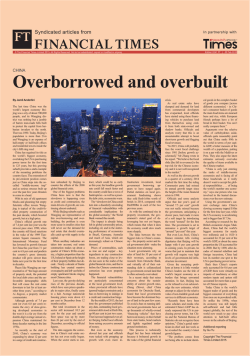
Vol. 2015, No.3 - Central Bank of Ireland
Mary Cussen, Martin O’Brien, Luca Onorante & Gerard O’Reilly1 Economic Letter Series Assessing the impact of macroprudential measures Vol 2015, No. 3 Abstract This Letter attempts to assess the potential impact of implementing the recently proposed proportionate loan-tovalue ratio on the wider housing market. Using a dual micro and macro simulation strategy, we find evidence for some moderate negative impacts of the LTV cap on house prices and mortgage interest rates, with a proportionately larger impact on housing supply. These can, however, be considered to be close to the maximum possible impacts given the conservative assumptions and empirical strategies underlying our analysis. 1 Introduction Macro-prudential policies to promote financial stability and safeguard the economy from the negative consequences of unsustainable credit growth have been implemented in a number of countries in recent years. In many instances, these policies include restrictions on mortgage lending above certain loan-to-value (LTV) and loan-to-income (LTI) ratios, mitigating the exposure of both banks and borrowers to potentially large losses in the event of a negative shock to the housing market. The Central Bank of Ireland has proposed to implement proportionate LTV and LTI restrictions on new mortgage lending (CBI, 2014), with recent analysis highlighting the potential impact of such a policy on credit quality in the Irish context (Hallisey et al, 2014). In framing such a policy, however, it is also necessary to consider the wider impact on the housing market. This Letter examines the potential impact of implementing the proposed macroprudential measures2 in terms of new mortgage lending, house prices and housing supply. Adopting a methodology similar to that used in macroprudential policy evaluations in other countries, we simulate the response of these variables to the proposed proportionate LTV cap on principal dwelling mortgages under a number of scenarios, and compare these to the outcomes that could be expected in a “no policy change” context. The Letter proceeds as follows: Section 2 reviews the methodological approaches in the international literature to assessing the impact of LTV caps as well as some of the empirical findings of those analyses; Section 3 discusses our approach 1 Email: [email protected], [email protected], [email protected], [email protected]. The views expressed in this paper are those of the authors and do not necessarily reflect those of the Central Bank of Ireland or the ESCB. We thank Terry O’Malley, Christian Danne and Graeme Walsh for assistance with the data and helpful conversations about this piece. Comments from Rea Lydon, Tara McIndoe Calder and Gabriel Fagan are also gratefully acknowledged. 2 The proposed measures include a ceiling of 80 per cent on the LTV for 85 per cent of the value all new mortgage lending for primary dwellings, and an LTI limit of 3.5 times gross annual income covering 80 per cent of the value of new mortgages. Our analysis focusses on the proposed LTV cap as this is found to be the most binding. Cussen, O’Brien, Onorante & O’Reilly - Assessing the impact of macroprudential measures given the issues raised in other studies and the data available; while Section 4 presents the results of the simulation exercise; Section 5 discusses some caveats to our analysis which are relevant in interpreting the simulation results; and Section 6 concludes. 2 International evaluations of LTV caps A number of cross country studies have highlighted the effectiveness of LTV and LTI caps on curbing mortgage credit growth and reducing the probability of dangerously excessive rises in property prices3 . However the exact channels through which these policies become effective and their wider economic impact are less well understood. This follows from the fact that a consensus on theoretical models of how the financial system and the real economy interact is only slowly emerging (Galati and Moessner, 2014). Empirical assessments of the impact of LTV and LTI caps on the wider housing market are limited by the relatively short time they have been in operation in many countries4 . There are also difficulties in appropriately identifying the effects of LTV and LTI caps, as they are often introduced alongside other policy measures as well as being implemented in differrent ways. The focus in this Letter is the wider impact of LTV restrictions on the economy generally, and the housing market in particular. Ahuja and Nabar (2011) analyse the impact of a tightening of LTV restrictions in Hong Kong. Using reduced form vector autoregressions (VARs) they find evidence that more binding LTV caps lead to reduced housing market transactions than would otherwise have been the case after around a year, with house price growth easing approximately two years after the policy change and mortgage lending being unaffected. In contrast, Igan and Kang (2011) show a large and significant negative impact on housing transactions in the three months after announcements of tighter LTV caps in South Korea, with house price growth slowing within six months of policy implementation. New Zealand introduced proportionate LTV caps in 2013 similar to those proposed for Ireland. In advance of the policy being implemented, Bloor and McDonald (2013) using a Bayesian VAR (BVAR) model estimate that the hypothesised reduction in mortgage growth of 1-3 percentage points in the year after the policy would lead to house price inflation being 1-4 percentage points lower over that period. They also estimate that the impact on new housing supply, proxied by monthly building consents, would be strongest 12 months after the policy introduction at approximately 80 units lower than a no policy scenario (building consents in the two years prior to the LTV caps averaged 1,491 per month). However these results are sensitive to the fact that the policy shock was calibrated to proxy a reduction in new mortgage lending using separate shocks to housing sales and interest rates, as new lending was not included in their BVAR. Price (2014) conducted an early postimplementation analysis of the impact of the cap in New Zealand. Using an extended version of the Bloor and McDonald (2013) model, she finds evidence that the policy has contributed to housing transactions and mortgage approvals being significantly lower than the no-policy counterfactual in the six months after implementation. However, she finds that neither house price growth nor household credit growth had been significantly negatively impacted by the policy at that early stage. 3 Our technical approach We adopt a two-step simulation strategy to estimate the impact of the proposed LTV cap on the wider housing market in Ireland5 . First, making use of loan-level data on primary dwelling mortgages collected as part of the Financial Measures Programme (FMP)6 , we conduct a micro-simulation exercise to determine the poten- 3 See IMF (2013) for a summary. notable exception is the case of Hong Kong, where LTV caps have been in place since 1991 (Ahuja and Nabar, 2011; Wong et al, 2014; Gerlach and Peng, 2005). 5 The analysis discussed here focusses on the LTV restriction, as this is shown to be the most binding. The impacts of joint imposition of the proportionate LTV and LTI caps are qualitatively similar to the LTV case alone, and of a slightly larger magnitude quantitatively. 6 The banks included in the FMP were Allied Irish Banks plc (including EBS), Bank of Ireland and Permanent TSB. It is estimated that these banks accounted for 70 per cent of new mortgage lending during our sample period. For a detailed discussion of the loan-level data see Kennedy and McIndoe Calder (2011). 4A 2 Cussen, O’Brien, Onorante & O’Reilly - Assessing the impact of macroprudential measures tial impact of the proposed measures on new mortgage lending. We restrict our sample to new mortgages issued in 2013 and the first half of 2014, as they most accurately reflect the recent behaviour of new mortgage holders. Figure 1 plots the distribution of these loans by LTV. It can be seen that a significant portion of these loans were issued above the proposed cap of 80 per cent LTV (Figure 1 the dashed red line is centred in the bin containing 80 per cent LTV). In total, 44 per cent of loans by number in our sample were issued above the proposed cap. The spike in the distribution occurs for loans between 90-95 per cent LTV, indicating that this was the most frequent outcome in our sample. Overall, the weighted LTV in the sample is 75 per cent. Assuming that potential new customers have a similar demand for mortgages based on the characteristics of loans issued in our sample, we simulate the decline in the value and volume of new mortgage lending had the policy measures been in place. In doing this it is necessary to consider various scenarios to take into account potential borrower behaviour. For example, if a borrower’s desired LTV is 85 per cent but the bank is restricted to offer 80 per cent, the borrower may decide in two extreme scenarios to either: • Accept the offer and use alternative funds to make up the shortfall in the purchase price of the property; • Reject the offer and forego purchasing the property. Both extremes are unlikely to hold across the entire distribution of affected borrowers. It is more reasonable to assume that borrowers whose desired (>80 per cent) LTV is close to the maximum LTV being offered under the new regime will accept the offer, whereas those farther away are less likely to accept the offer. This difference across the distribution of borrowers affected by the cap is due to their potential access to other funds (e.g. own savings) to finance the purchase of a property, their ability to negotiate a lower purchase price with the vendor, or to find an alternative property for purchase. To capture this we assume the following cautious behavioural function for borrowers based on the difference between the desired LTV and the maximum LTV possible under the proposed cap: ACCEPT % 1 LTV DESIRED 80 This function yields an exponential decline in the proportion of borrowers accepting the lower than desired LTV of 80 per cent, moving from a case where all buyers with a desired LTV of 81 per cent accept, to the case where only one-fifth of borrowers accept if their desired LTV is 85 per cent, and so on (Figure 2). This reasonable, yet conservative distribution for borrower behaviour is our third scenario. In our micro-simulation we impose the proposed proportionate LTV cap to the sample of loans in our dataset under the three scenarios of: 1. everyone accepting the loan offer; 2. everyone rejecting the loan offer; 3. the more realistic middle case scenario based on the borrower behaviour function. In all cases the proportionate nature of the LTV cap is accounted for, in that banks are allowed to issue 15 per cent of the value of their new mortgage lending at above 80 per cent LTV7 . For each of the scenarios, the simulation yields a reduction in the value and number of new mortgages as a result of the new policy. Our second step takes the micro-simulation result from the more realistic third scenario and imposes it as a shock in a model which includes new mortgage lending, house prices, housing completions, the mortgage interest rate and the unemployment rate8 . Similar to Bloor and McDonald (2013), we estimate the model as a BVAR. VARs generally, and BVARs in particular, are flexible time 7 The distribution of the 15 per cent of loans issued above the LTV cap is assumed to match that of all loans above 80 per cent LTV in the original distribution of our sample. 8 The model is estimated in log levels (except the interest rate) on seasonally adjusted quarterly data from 1992q3-2014q2. New mortgage lending is sourced from the BPFI Housing Market Monitor, backcast using data from the Department of the Environment Housing Statistics (DoEHS); house prices are taken from the CSO Residential Property Price Index, backcast using the ESRI/PTSB House Price Index and DoEHS; housing completions are the number of housing units constructed in the period sourced from DoEHS; the mortgage interest rate is the new business rate sourced from the Central Bank of Ireland Retail Interest Rate Statistics; and the unemployment rate is the ILO rate from the QNHS backast using Live Register data, both from the Central Statistics Office. 3 Cussen, O’Brien, Onorante & O’Reilly - Assessing the impact of macroprudential measures series models which can effectively describe the underlying relationships between variables without the econometrician imposing what can be arbitrary restrictions, particularly in the absence of an underlying theoretical framework9 . We impose a shock to new mortgage lending consistent with the results of our micro-simulation, and allow for the shock to decay gradually over a period of thirty quarters. The rationale for the shock to decay is that people who are initially credit rationed as a result of the LTV cap may be able to save for a period of time and re-enter the mortgage market succesfully at a later date. We then compare the estimated future path of house prices, housing completions and the mortgage interest rate in the context where the proposed proportionate LTV cap is in place to the estimated outcomes for these variables in the “no policy change” context. 4 Simulation results The results of our micro-simulation are summarised in Table 1. In the extreme scenario of everyone accepting a maximum LTV of 80 per cent there is by definition no reduction in the number of loans issued, with the value of new mortgage lending being 4 per cent below what would have been the case if there was no LTV cap. Given the reduction in the value of new loans, the weighted LTV on new mortgages falls from 75 per cent absent the policy to 70 per cent. The spike in the original distribution of new mortgages at 90-95 per cent LTV (Figure 1) now shifts to 80 per cent, with the mortgages issued above 80 per cent consistent with the 15 per cent proportionate quota in the proposed policy (Figure 3). In the other extreme scenario, where everyone affected by the LTV cap rejects the lower LTV loan offer, there is a sizeable decline in both the value and number of new lending of 42 per cent and 37 per cent respectively (Table 1). Consequently the weighted LTV of new mortgages falls by 11 percentage points, and the distribution of new mortgages by LTV is relatively flat compared to the original distribution in our sample (Figure 4). Under the third scenario, the number of new mortgages falls by 5 per cent and is accompanied by a proportionately higher decline of 9 per cent in the value of new lending (Table 1). The combined impact of these movements leads to a reduction in the weighted LTV of new mortgages of 5 percentage points to 70 per cent. The distribution of new mortgages in this scenario is similar to that of the first where everyone accepts the lower LTV (Figure 5). The peak shifts to the maximum 80 per cent LTV, albeit that peak is some 10 percentage points below the original distribution in our sample. We focus on this third scenario when we calibrate the initial shock to the BVAR model - a reduction of 9 per cent in the value of new mortgage lending in the quarter in which the proposed LTV cap is implemented. The estimates of the effect of the loan shock on the other main variables in the system is shown in Figure 6. These should be interpreted as deviations from the baseline outcome which would arise if there was no policy change. In terms of mortgage interest rates, the impact is most prominent over the first year after implementing the LTV cap, with interest rates estimated to be 0.38 percentage points lower four quarters after the policy than would otherwise have been the case. The effect on house prices, however, is longer and more pronounced. After the first year, house prices are approximately 0.8 per cent lower than in a “no policy change” context, with that effect rising to 1.3 per cent after three years before tapering off. This result would be moderate in comparison to other studies in the international literature (Section 2). House prices are permanently lower after the introduction of the LTV cap when compared to the baseline of no LTV cap. The impact of the loan shock due to the LTV cap on the number of housing completions is plotted in Figure 610 . During the first full year after the shock, housing completions are approximately 380 units lower than what would have been the case (approximately 2.1 per cent below the level of completions in the “no policy change” baseline). The effect of the loan shock is at its strongest approximately 8 quarters after the implementation of the policy, with housing completions being some 150 units lower in that quarter than would otherwise be the case in the baseline scenario. Completions remain below the baseline for some 7 years after the implementation of the LTV cap. 9 See Koop and Korobilis (2010) for a review of the use of BVARs in modern macroeconomics. baseline of no policy change is consistent with Central Bank of Ireland forecasts for housing completions in 2015 and 2016, with the growth in completions after that reverting gradually to it’s long run trend by 2025. 10 The 4 Cussen, O’Brien, Onorante & O’Reilly - Assessing the impact of macroprudential measures 5 Caveats to our analysis Estimates of the impact of a potential new policy regime using historic data are always subject to uncertainty. Beyond this universal issue, there are a number of caveats that should be taken into account when interpreting our simulation results. In all cases these point toward the likelihood that our results are close to the maximum possible effects of the introduction of the proposed LTV caps. First, in the micro-simulation we assume that banks do not change the distribution of their offered LTVs. It is possible however in an a bid to gain market share that a bank would discourage very low LTVs in order to increase the amount of loans it can offer closer to and above the proportionate LTV cap. If this was the case, the reduction in the value of new mortgage lending as a result of implementing the LTV cap would be smaller than that estimated in our middle case scenario, thus leading to a lower shock to house prices, completions and mortgage interest rates than what we have specified. Second, standard price elasticities of housing supply in the international literature lie in the range of 0.5 to 1 (Caldera Sanchez and Johansson, 2011). The implicit elasticity of housing supply to changes in house prices in our BVAR model is much higher, at approximately 1.6. This reflects the sample period over which the model was estimated, including the collapse in the housing market during the crisis. In the crisis period house prices declined by approximately 50 per cent, whereas housing completions fell by over 90 per cent, driving up the overall elasticity in our esti- mation period. Were we to impose an elasticity of housing supply in line with international evidence in the BVAR, the responsiveness of housing supply to the loan shock arising from the LTV cap would be even smaller than what we presented in the previous section. Third, both the behavioural function used in generating our third scenario in the microsimulation and our assumed rate of decay in the loan shock in the BVAR can be considered as conservative. If more borrowers accept the offered LTV under the cap than in our more realistic third scenario, or borrowers who are excluded were able to save and re-enter the market at a more rapid pace than we currently assume, then the overall size of the new lending shock would diminish. Taking these mitigating factors into account, this suggests that the conservative approach in our analysis errs on the side of overestimating the impact of the proposed cap. 6 Concluding remarks Evaluating the wider impact of macroprudential policies is an important prerequisite for policy makers to consider. In this Letter we adopt a versatile methodology with conservative assumptions in assessing the impact of the proposed LTV cap in Ireland. The findings of our analysis suggests that the new policy would indeed have a long-run impact on the wider housing market in Ireland. These impacts are relatively moderate in terms of house prices and mortgage interest rates, albeit slightly less so in terms of housing supply. References [1] Ahuja, A. and M. Nabar (2011). Safeguarding Banks and Containing Property Booms: Cross-Country Evidence on Macroprudential Policies and Lessons from Hong Kong SAR, International Monetary Fund Working Paper, No. WP/11/284. [2] Bloor, C. and C. McDonald (2013). Estimating the Impacts of Restrictions on High LVR Lending, Reserve Bank of New Zealand Analytical Note, No. AN2013/05, October. [3] Caldera Sanchez, A. and A. Johansson (2011). The Price Responsiveness of Housing Supply in OECD Countries, OECD Economics Department Working Papers, No. 837. [4] CBI (2014). Macro-prudential Policy for Residential Mortgage Lending, Central Bank of Ireland Consultation Paper CP87. [5] Galati, G. and R. Moessner (2014). What do we Know About the Effects of Macroprudential Policy, De Nederlandsche Bank Working Paper, No. 440, September. 5 Cussen, O’Brien, Onorante & O’Reilly - Assessing the impact of macroprudential measures [6] Gerlach, S. and W. Peng (2005). Bank Lending and Property Prices in Hong Kong, Journal of Banking and Finance, 29(2), 461-481. [7] Hallisey, N., R. Kelly and T. O’Malley (2014). Macro-prudential Tools and Credit Risk of Property Lending at Irish Banks, Central Bank of Ireland Economic Letters, No. 10/EL/14. [8] Igan, D. and H. Kang (2011). Do Loan-to-Value and Debt-to-Income Limits Work? Evidence from Korea, International Monetary Fund Working Paper, No. WP/11/297. [9] IMF (2013). Key Aspects of Macroprudential Policy - Background Paper, International Monetary Fund, June. [10] Kennedy, G. and T. McIndoe Calder (2011). The Irish Mortgage Market: Stylised Facts, Negative Equity and Arrears, Central Bank of Ireland Research Technical Paper, No. 12/RT/11. [11] Koop, G. and D. Korobilis (2010). Bayesian Multivariate Time Series Methods for Empirical MacroeR conomics, Foundations and Trendsin Econometrics, Vol 3, No. 4, pp 267-358. [12] Price, G. (2014). How has the LVR Restriction Affected the Housing Market: A Counterfactual Analysis, Reserve Bank of New Zealand Analytical Note, No. AN2014/03, May. [13] Wong, E., A. Tsang and S. Kong (2014). How Does LTV Policy Strengthen Banks Resilience to Property Price Shocks: Evidence from Hong Kong, HKIMR Working Paper, No. 3/2014, February. 6 Cussen, O’Brien, Onorante & O’Reilly - Assessing the impact of macroprudential measures Figure 1: Sample Distribution of New Mortgage Drawdowns in 2013/2014 by Originating LTV 6000 Number of mortgages 5000 4000 3000 2000 1000 0 0 50 100 150 LTV at origination Source: Central Bank of Ireland, Loan-Level Data. Dashed red line centred at bin containing 80 per cent LTV. Figure 2: Borrower Behaviour Function for Scenario 3 Proportion of mortgage applicants who accept max 80% LTV 1 0.9 0.8 0.7 0.6 0.5 0.4 0.3 0.2 0.1 0 0 50 100 150 Original LTV sought Source: Author’s calculations. 7 Cussen, O’Brien, Onorante & O’Reilly - Assessing the impact of macroprudential measures Figure 3: Distribution of New Mortgage Drawdowns by Originating LTV - Scenario 1 6000 Number of mortgages 5000 4000 3000 2000 1000 0 0 50 100 150 LTV at origination Source: Author’s calculations. Dashed red line centred at bin containing 80 per cent LTV. Figure 4: Distribution of New Mortgage Drawdowns by Originating LTV - Scenario 2 6000 Number of mortgages 5000 4000 3000 2000 1000 0 0 50 100 150 LTV at origination Source: Author’s calculations. Dashed red line centred at bin containing 80 per cent LTV. 8 Cussen, O’Brien, Onorante & O’Reilly - Assessing the impact of macroprudential measures Figure 5: Distribution of New Mortgage Drawdowns by Originating LTV - Scenario 3 6000 Number of mortgages 5000 4000 3000 2000 1000 0 0 50 100 150 LTV at origination Source: Author’s calculations. Dashed red line centred at bin containing 80 per cent LTV. Figure 6: Deviation from “No policy’ Baseline - Middle Case Scenario Source: Author’s calculations. 9 Cussen, O’Brien, Onorante & O’Reilly - Assessing the impact of macroprudential measures Table 1: Microsimulation Results of LTV Cap Loans affected by policy (number%) 44% Weighted LTV before policy 75% Scenario 1: Everyone accepts offer Change in new mortgage lending (value) Change in new mortgage lending (number) Weighted LTV after policy -4% 0% 70% Scenario 2: Everyone rejects offer Change in new mortgage lending (value) -42% Change in new mortgage lending (number) -37% Weighted LTV after policy 64% Scenario 3: Behaviour function of difference between asked and proposed LTV Change in new mortgage lending (value) -9% Change in new mortgage lending (number) -5% Weighted LTV after policy 70% Source: Author’s calculations. Notes: “Change” refers to the difference from the actual outcome in our sample. 10
© Copyright 2026






